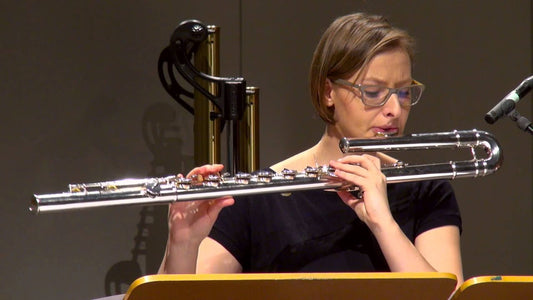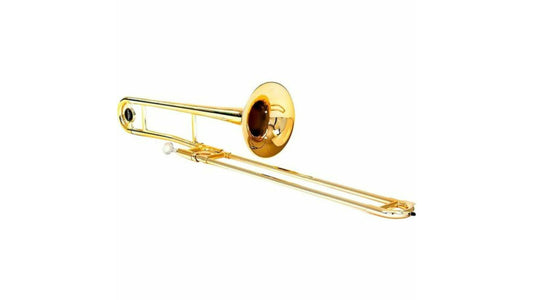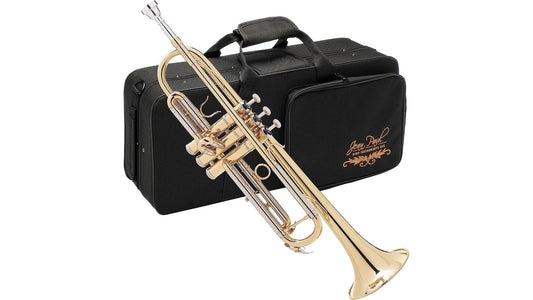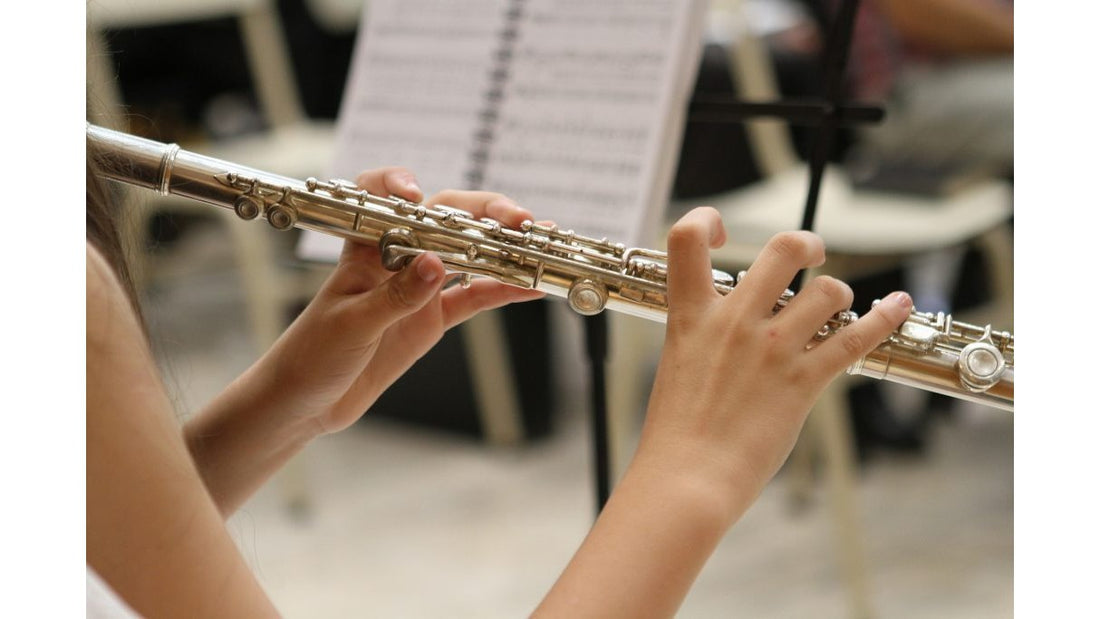
Lịch Sử và Quá Trình Phát Triển Của Flute
Flute không chỉ đơn thuần là một sản phẩm của kỹ thuật âm thanh hiện đại, mà trên thực tế, nó là một nhạc cụ có niên đại từ thời kỳ đồ đá và là nhạc cụ mà nhiều nhà sử học tin rằng đây là một trong những nhạc cụ đầu tiên từng được tạo ra.
Trong bài viết này, chúng ta sẽ khám phá nguồn gốc của flute mà chúng ta biết và yêu thích ngày nay. Chúng ta sẽ theo dõi quá trình phát triển của nó từ những mảnh xương có lỗ, được tìm thấy cách đây khoảng 40.000 năm cho đến những cây flute được mài giũa kỹ càng, điều chỉnh đồng đều và nhạy bén trong thời kỳ hiện đại. Cây flute đã trải qua một hành trình phát triển độc đáo, tuy nhiên, cây flute ngày nay liệu đã phải là đích đến cuối cùng hay chưa, hãy cùng tìm hiểu!
Giống như phần lớn lịch sử cổ đại, nguồn gốc chính xác của âm nhạc là không chắc chắn, nhưng người ta cho rằng những âm thanh sớm nhất được tạo ra bởi giọng nói của con người và có thể là do các hiệu ứng âm thanh 'tình cờ' như âm thanh được tự nhiên tạo ra trong môi trường hoặc từ các các công việc hàng ngày, chẳng hạn như nấu ăn, sử dụng các công cụ, v.v.
Cây flute đầu tiên
Divje babe là địa điểm khảo cổ lâu đời nhất của Slovenia. Cũng là nơi tiến sĩ Ivan Turk phát hiện ra cây flute đầu tiên làm từ ống xương đùi loài gấu hang động năm 1998. Cây flute này có hai lỗ hoàn chỉnh và hai lỗ còn chưa hoàn chỉnh. Người ta gọi đây là 'flute Divje babe'. Do khu vực mà người ta tìm thấy câu flute này và các đồ chế tạo khác được phát hiện trong cùng một lớp khai quật, các chuyên gia tin rằng nó chắc chắn có niên đại ít nhất 40.000 năm, thậm chí là khoảng 60.000 năm tuổi.
Sau khi thực hiện phân tích, các chuyên gia nhận thấy loại xương được dùng để chế tạo flute này là của người Neanderthal và là nhạc cụ duy nhất được phát hiện cho đến nay có thể được chơi bởi tổ tiên người Neanderthal của chúng ta. Tuy nhiên, cho đến tận ngày nay, lịch sử xuất hiện chính xác cây flute này vẫn đang là một đề tài gây nhiều tranh cãi. Một số nhà sử học đã cố gắng giải thích các lỗ trên cây sao thực chất là những vết cắn ngẫu nhiên nhưng lý thuyết này không phù hợp với kích thước răng của các loài động vật được cho là tồn tại trong khu vực vào thời điểm đó. Ngược lại, nếu được tạo ra một cách có chủ ý, cây flute sẽ thể hiện một trình độ kỹ năng đáng ngạc nhiên đối với người Neanderthal.
Cho đến nay, các cuộc tranh luận vẫn tiếp tục gay gắt, nhưng Slovenia đã tuyên bố một cách chính đáng rằng flute Divje babe là báu vật quốc gia và là điểm thu hút khách du lịch, đồng thời đặt nó trong bảo tàng quốc gia của họ dưới biểu ngữ là nhạc cụ lâu đời nhất trên thế giới. Các bản sao hiện đại của nhạc cụ đã được tạo ra và được chơi thường xuyên ở Slovenia, đáng chú ý nhất là của nhạc sĩ Ljuben Dimkaroski.
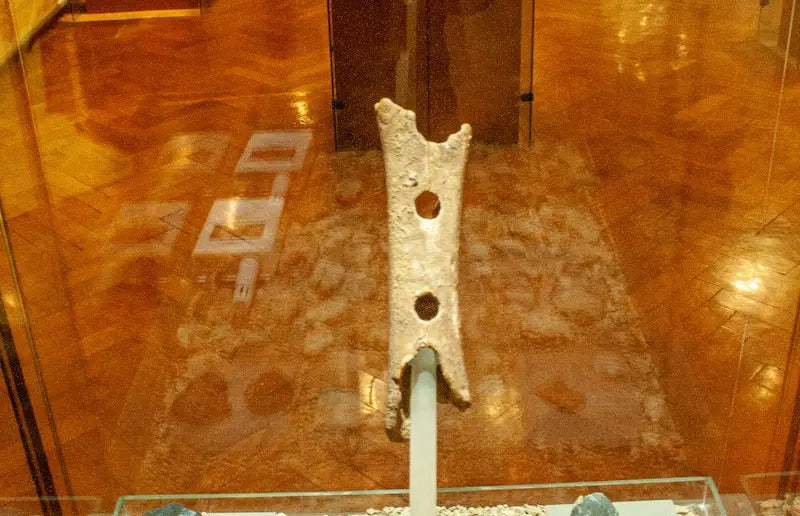
Divje Babe Flute
Từ trong những bức tranh từ thời kỳ La Mã những năm đầu thế kỷ thứ 10, người ta đã nhận thấy những cây flute thời kỳ này được chơi bên tay trái, thay vì tay phải như ngày này. Những bức tượng đồng và những bức tranh tường ở thời kỳ này cũng cho thấy dấu vết, bằng chứng tồn tại của cây flute ngang. Những cây flute thời kỳ này mang dáng dấp flute tiêu hơn là những cây flute Flute chuyên nghiệp ngày nay.
Những khám phá tiếp theo
Mặc dù flute Divje babe được cho là nhạc cụ lâu đời nhất, nhưng có khả năng flute đã được phát minh nhiều lần trên khắp thế giới vào những thời điểm khác nhau trong lịch sử. Khi lập biểu đồ tiến trình phát triển của nó, chúng ta chỉ có thể dựa vào bằng chứng được ghi chép lại do các nhà sử học và khảo cổ học tìm thấy. Và trong lịch sử đó đã có ghi chép rất nhiều về những cây flute khác được tìm thấy ở Ai Cập, Israel, Trung Quốc, Ấn Độ và Hy Lạp.
Từ sự sụp đổ của Đế chế La Mã vào khoảng năm 400 sau Công nguyên cho đến khoảng năm 1100 sau Công nguyên, người ta ít nghe thấy tiếng flute và có nhiều học giả cho rằng flute đã biến mất trong vài thế kỷ. Mãi đến thế kỷ 11 và 12 , flute mới bắt đầu xuất hiện trở lại, có lẽ bắt đầu từ nước Đức. Vào đầu thế kỷ 15 , flute được thể hiện trong nhiều bức tranh khác nhau trên khắp Tây Âu và hơn thế nữa. Ở giai đoạn này, flute vẫn được làm từ xương nhưng phức tạp hơn so với các ví dụ cổ xưa được mô tả ở trên.
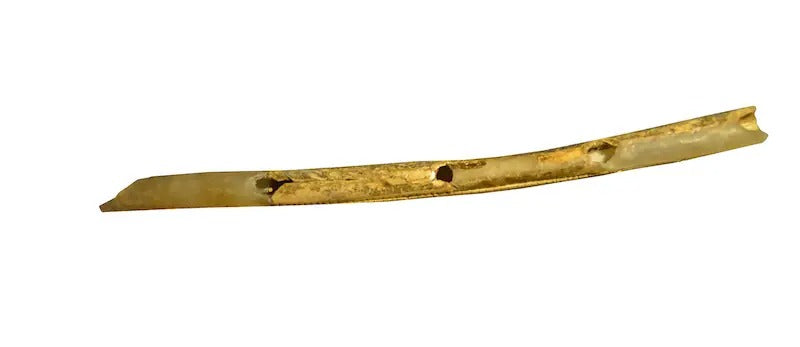
Flute cổ đại
Flute trong thời kỳ Phục Hưng
Trong suốt thời kỳ Phục Hưng vào thế kỷ 16, flute là một trong những nhạc cụ phổ biến nhất trong nền âm nhạc rất sôi động của Ý. Nhạc cụ này được đánh giá cao, thậm chí còn được sưu tầm bởi Henry VIII, người là một nghệ sĩ biểu diễn flute, đàn hạc, kèn, đàn luýt và đàn lia. Một bản kiểm kê bộ sưu tập nhạc cụ thời kỳ Phục Hưng của ông sau khi ông qua đời vào năm 1547 cho thấy ông sở hữu hơn 70 máy phát nhạc, 40 cây flute và các loại nhạc cụ khác bao gồm kèn túi, ống flute, đàn tỳ bà và khăn choàng (tiền thân của đàn oboe hiện đại).

Flute thời bấy giờ rất đơn giản, gồm một ống gỗ, hình trụ, một đầu bịt nút bần, một lỗ thổi và sáu lỗ nhỏ. Do không có các phím đàn phức tạp, những cây flute này chỉ có thể tạo ra một số nốt nhạc hạn chế nên chúng được làm với các kích cỡ khác nhau, cao độ ở các phím khác nhau.
Vào giữa năm 1320, cây flute gỗ một khúc với chiều dài khoảng 60cm đã ra đời, có giọng “Rê”, vào năm 1511 Zwerchpfeiff đã cho ra đời cây flute với 6 lỗ, và tới năm 1529, kiểu flute giọng cao, trung thấp và trầm ra đời.
Thời kỳ Baroque đến ngày nay
Từ thời Tudor cho đến ngày nay, sự phổ biến và phát triển của flute ngày càng lớn. Đã có nhiều thay đổi với thiết kế ban đầu tác động đến ngữ điệu, tính linh hoạt và chất lượng âm thanh của flute. Tuy nhiên, về cơ bản, flute thời kỳ này vẫn có thiết kế theo kiểu ống dài với những lỗ nhỏ đơn giản.
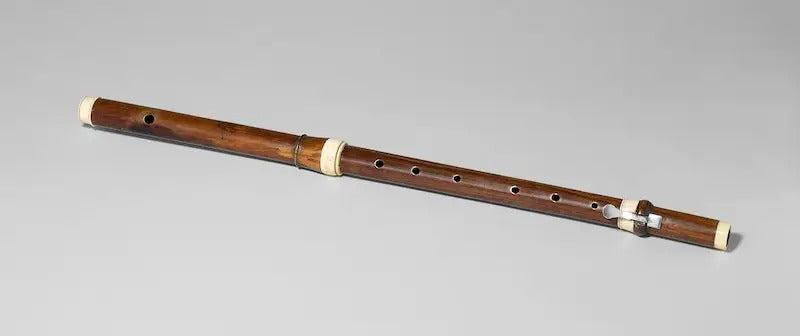
Baroque Flute
Những thay đổi chính, được thực hiện bởi một số lượng tương đối nhỏ các nhà sản xuất flute có ảnh hưởng lớn, được nêu dưới đây:
Flute Hotteterre: thập niên 1670
Flute thiết kế được chia thành ba phần: khớp đầu, thân và khớp chân.
Phần thân và khớp chân hình nón, thân flute có đường kính hẹp dần về phía đáy, trong khi khớp đáy mở rộng ra tạo thành một chiếc chuông nhỏ. Thiết kế này vẫn được tuân theo trong một số piccolos hiện đại.
Phím đầu tiên được thêm vào ở dưới cùng để cho phép sử dụng nhạc cụ với việc các ngón bấm phức tạp, chơi tất cả các nốt màu mặc dù cách điều chỉnh vẫn còn một chút thay đổi. Các lỗ ntrên thân flute đã được làm nhỏ hơn nhiều.
Đến năm 1720, cây flute đã được chia nhỏ hơn với phần thân bây giờ thành hai phần với các khớp phụ có độ dài khác nhau được gọi là 'corps de Recharge'. Điều này cho phép người biểu diễn thay đổi cao độ của nhạc cụ để phù hợp với các dàn nhạc khác nhau. Những cây flute này được gọi là flute baroque.
Quantz và Tromlitz: 1750 – 1790
Cả hai nghệ sĩ biểu diễn này đã viết những chuyên luận dài về sự phát triển của flute, bao gồm cả việc hình thành các cách bấm ngón mới cho từng nốt trên nhạc cụ để cải thiện cao độ và ngữ điệu. Đặc biệt, Quantz đã nghiên cứu chi tiết các vấn đề về ngữ điệu của nhạc cụ và giới thiệu một thanh trượt điều chỉnh và phím phụ.
Tuy nhiên, bất chấp điều này, những người làm flute vẫn không hài lòng về cách điều chỉnh của nhạc cụ và độ phức tạp của cách bấm ngón cần thiết, vì vậy họ đã thêm các phím khác để cải thiện việc tạo ra phím F, B phẳng và G sắc nét.
Sau đó, hai phím được thêm vào khớp đáy để thành phím C và C thăng, đến cuối thế kỷ 18, hai phím nữa đã được giới thiệu, đây có thể được coi là tổ tiên của flute 8 phím.
Theobald Boehm: 1794 – 1881
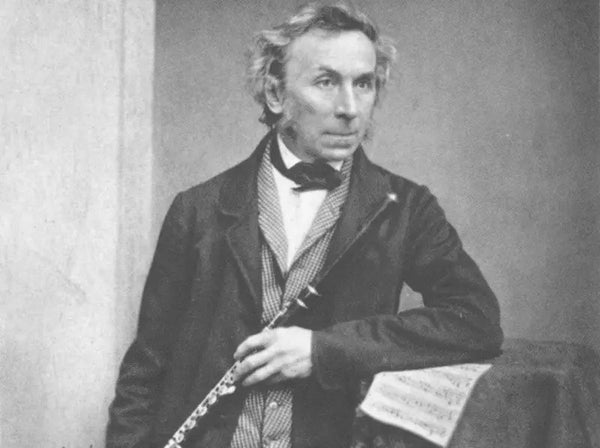
Theobald Boehm
Boehm là một thợ kim hoàn chuyên nghiệp có năng khiếu âm nhạc mạnh mẽ, được biết đến với danh hiệu "cha đẻ của flute hòa nhạc". Chính những đổi mới của ông, dựa trên việc bổ sung các phím như mô tả ở trên, đã thực sự tạo ra nhạc cụ mà chúng ta biết ngày nay.
Thiết kế đầu tiên của Boehm bắt đầu từ năm 1832, liên quan đến việc tạo ra một cơ chế mới có chức năng như một phần mở rộng của các ngón tay, liên kết các phím bằng một loạt trục di động.
Điều này có nghĩa là lần đầu tiên, các lỗ có thể được đặt cách nhau tùy theo đặc tính âm thanh của flute và đặc biệt là để tạo ra ngữ điệu mạnh mẽ, thay vì có kích thước thuận tiện cho ngón tay của người chơi. Điều này đã tạo ra sự khác biệt rất lớn đối với ngữ điệu của nhạc cụ.
Đến năm 1847, Boehm đã nghiên cứu về âm học và đưa ra một thiết kế lại khác, lần này với thân hình trụ, khớp chân và khớp đầu hình parabol. Lỗ khí không còn hình tròn hay hình bầu dục nữa mà là hình chữ nhật với các góc bo tròn.
Các lỗ trên nhạc cụ này thậm chí còn lớn hơn so với thiết kế trước đó (một cải tiến được giới thiệu nhằm cố gắng làm cho nhạc cụ to hơn) và không thể dễ dàng bị các ngón tay che lại, vì vậy ông đã thiết kế các cốc đệm cho mỗi lỗ để đảm bảo không khí không thể thoát ra ngoài.
Lò xo chốt và phím vòng kim loại sau đó đã được thêm vào để tạo điều kiện thuận lợi cho việc đóng và mở phím và có lẽ quan trọng nhất là nhạc cụ này được làm từ bạc chất lượng cao của Đức, loại mà Boehm tin rằng có chất lượng âm thanh tốt nhất hiện có. Nhạc cụ này ngay lập tức được ca ngợi là một cải tiến to lớn, và thiết kế của nó đã mang về cho Boehm một số giải thưởng, trong đó có một giải tại Triển lãm Thế giới ở Paris năm 1855.
Năm 1860, flute Boehm được công nhận là nhạc cụ chính thức của Nhạc viện Paris.
Năm 1877 là dấu mốc lịch sử khi Boehm hoàn thiện “cây flute bạc hiện đại”. Cây flute Macauley được làm bằng bạc với lỗ thổi bằng vàng. Cây flute cũng có nhíp nhún bằng vàng và thêm nốt “Si” ở cuối flute.
Cuối thế kỷ 19, cây flute xuất hiện trong các bản nhạc và dàn nhạc của Brahms, Strauss và Tchaikovsky, với những khả năng kỹ thuật mở rộng. Rất nhiều các nhạc sĩ sáng tác những tác phẩm độc tấu văn hoa bóng bẩy cùng những tác phẩm biểu diễn điêu luyện trở thành mốt thời thượng. Cây flute giờ đây đã có thể chơi được âm nhạc mà những nhạc cụ trước thời Boehm coi là những đòi hỏi kỹ thuật quá khó. Phạm vi rộng mà các nhạc sĩ sáng tác thời kỳ lãng mạn đòi hỏi cây flute là có thể chơi được 3 quãng 8.
Tuy nhiên, sự tôn thờ nhạc cụ này không phổ biến với một số nghệ sĩ biểu diễn và nhà soạn nhạc (đáng chú ý là Richard Wagner), đặc biệt là ở Đức, Ý và Nga. Ở những nước này, các nghệ sĩ miễn cưỡng chấp nhận sử dụng loại sao với hệ thống phím mới.
Flute Kỷ Nguyên Hiện Đại
Đáng ngạc nhiên là một số sửa đổi đã được thực hiện trong phần sau của thế kỷ 19 và trong suốt thế kỷ 20 nhưng có một số nhân vật có ảnh hưởng đã thực hiện một số sửa đổi quan trọng:
Albert Cooper (những năm 1960) – Cooper đã sửa đổi cơ chế của Boehm để giúp flute hiện đại chơi dễ dàng hơn. Flute đã được điều chỉnh lại thành A440 và lỗ khí được cắt theo cách mới để cải thiện chất lượng âm thanh. Flute trở nên cực kỳ phổ biến với cả những người chuyên nghiệp và nghiệp dư.
Johann Brogger (những năm 1980) – Brogger đã sửa đổi thêm flute Boehm bằng cách khắc phục hai vấn đề lớn đã tồn tại gần 150 năm; điều chỉnh kém giữa các phím nhất định và các vấn đề giữa các phím phẳng G và B. Ông đã làm điều này bằng cách giới thiệu các trục không quay, tạo ra âm thanh êm hơn và ít ma sát hơn với các bộ phận chuyển động. Ngoài ra, các sửa đổi cho phép điều chỉnh lò xo riêng lẻ và flute được tăng cường. Tuy nhiên, flute Brogger không thực sự được ưa chuộng và chỉ được sử dụng bởi một số ít các nhà sản xuất lớn.
Kết luận
Ngày nay, bên cạnh những cải tiến, cây flute đã đạt đến mức phát triển hoàn thiện nhưng dường như vẫn còn chưa đủ. Cùng với sự phát triển của xã hội nói chung, âm nhạc luôn song hành và luôn có nhu cầu mong muốn thể hiện dòng chảy cuộc sống, cây flute cũng là bộ phận không tách rời.
Hòa cùng xu thế phát triển hiện đại hóa, âm nhạc cổ điển cũng luôn phải có sự cạnh tranh khốc liệt với dòng nhạc trẻ mới như Pop, Rock… Nhu cầu về thể hiện bản ngã con người luôn hình thành, định hình và đổi mới trong âm nhạc. Chính vì vậy mà ngày nay vẫn tiếp tục phát triển dòng âm nhạc mới mang tên Contemporary (nhạc đương đại). Tuy nhiên, giá trị của nhạc cổ điển vẫn mãi là giá trị vĩnh hằng không thể thay đổi.
Và để thể hiện dòng nhạc đương đại, những kĩ thuật biểu hiện của flute cũng có những thay đổi nhỏ. Đã xuất hiện nhiều kĩ thuật diễn tấu mới trên cây flute và có thể nói: Sự thể hiện âm nhạc của cây flute là không giới hạn.
Xem thêm:


